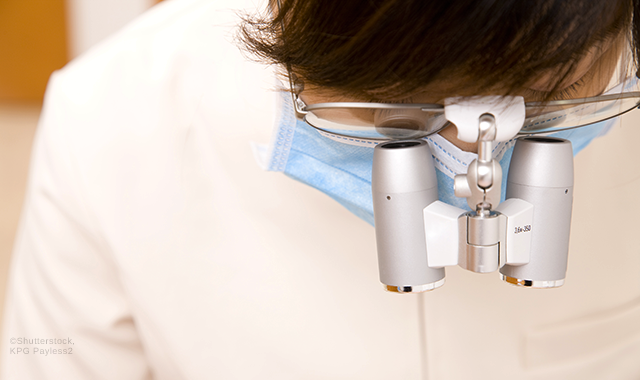4 biggest challenges of veneers — and how to solve them
More patients are requesting veneers, so here’s how you can ensure that the process goes smoothly.
Veneers are exciting; more patients are requesting them and more dentists are offering this cosmetic service in their practices. What’s not so exciting is the challenges associated with planning and placing veneers.

We talked to six cosmetic dentists to find out the biggest challenges they faced when placing veneers and what they did to overcome those obstacles. And while they came up with a few examples, they had even more solutions.
Trending article: Top 10 worst states to be a dentist
Read on to find out what challenges they’ve faced - and how you can prevent them.
Click through the slides to learn more.


Challenge 1: The seating appointment
One of the biggest challenges about placing veneers, and one that dentists mentioned over and over again, is seating them. In fact, one dentist said that while some people seek thrills through risky behavior such as bungee jumping, she prefers to get that kind of buzz from a seating appointment.
Another dentist calls it one of the most stressful and “exacting” appointments dentists can have.
“The seat appointment is always the toughest part,” says John Rowe, DDS, AAACD. “One misstep can have you starting over from square one.”
While dentists invest a lot of time and effort perfecting everything from the design and prep, the seating appointment requires exact precision to be a success.
More from the author: What a paperless practice really looks like
Solution: Plan and practice
“Plan, plan, plan and practice, practice, practice!” Dr. Rowe says. “Plan out each appointment before the patient is ever in the chair. Know exactly what steps you’re going to take and in which order you plan to take them.”
Dr. Rowe advises creating a checklist or a flowchart for the procedure, which he believes makes it more memorable - and he has a point. A recent study of university students from around the world (“Students’ use of paper and pen versus digital media in university environments for writing and reading - a cross-cultural exploration,” J Vincent) showed that handwritten notes were more likely to be retained than typed notes.
Solution: Take your time
“When you’re cementing veneers, you can’t be interrupted,” says Betsy Bakeman, DDS, FAACD. “It’s very meticulous work, so it’s important to allow enough time. Do not skip any steps.”
Dr. Bakeman says that every step is important, from trying the restoration to check for fit to carefully preparing both the tooth surface as well as the intaglio surface of the porcelain before bonding.
“I usually take out one half of the provisional restorations and leave the other half there, so I can compare the incisal edge position and the length of the tooth on the definitive porcelain restorations to my provisionals to make sure they’re spot on,” she explains. “Once I’ve established that they’re even and where they’re supposed to be, I try on every restoration individually to evaluate marginal integrity and fit, then I put all the restorations in together, check for tightness in between the teeth with floss, and adjust proximal contacts if need be until they are perfect.”
At that point, Dr. Bakeman takes photographs and gets patient approval before deciding how many she’ll seat at a time. Then, she’ll start the preparations.
“I allow a half an hour per tooth, so if we’re doing 10 teeth, it takes me five hours to do the whole procedure,” Dr. Bakeman says. “It takes a long time, but it’s very gratifying.”
Related reading: 6 cosmetic dentistry procedures every practice should offer
Solution: Dry fit and start at the center
John F. Weston DDS, FAACD, suggests doing a dry fit of the restorations before placing. To get the best results, he starts from the center and works his way out.
“Each restoration should be passive and seat fully,” he says. “This prevents problems when they are loaded with resin cement and are visually more difficult to adjust, if needed.”
He says that starting from one end and working around to the other side of the mouth causes each veneer to offset a little bit. By the time the dentist gets to the other side, the last one probably won’t fit.
“Having a system success where you try things in with a very controlled environment and understanding the need to seat more than one restoration can help to hold the other in position better,” he says.



Challenge 2: Saying ‘no’ when veneers aren’t the right option
Now that patients are more engaged with their treatment plans, many will come in requesting a procedure that’s not right for their situation. Some patients will request veneers not knowing what’s required to make them successful. Therefore, it’s up to the dentist to determine and communicate when veneers aren’t the right option.
“I had a patient in the other day who wanted veneers to fix the gaps in her teeth, but her teeth are in the wrong place,” says Fred H. Peck, DDS, AAACD. “Unless she does orthodontics, there is no way veneers are going to be successful on her.”
Trending research: Are dentists getting greedy over X-rays?
Solution: Proper diagnosis
The solution to this problem is proper diagnosis. “No matter what’s done, if you’re trying to use a veneer to fix a problem that has an underlying bite issue, the veneer is not going to be successful,” Dr. Peck explains. “You’ve got to make sure the occlusion is right for your best chance of a veneer to be successful.”
He says it starts with proper diagnosis and asking the questions, “Are veneers the correct treatment?” and “Is the bite correct?”



Challenge 3: Not having a good bond
For John F. Weston DDS, FAACD, the biggest challenge he sees for clinicians is an uncontrolled environment, which poses major issues when it’s time to bond the veneers. In fact, he sees these cases in his own practice. Dentists often see veneers on new patients that are falling off shortly after insertion.
“There can’t be any bleeding or saliva or moisture of any kind on the teeth or the internal surface of the veneer,” Dr. Weston says. “Everything needs to be kept extremely clean and controlled throughout the bonding steps.”
Solution: Allow patient time to heal and inform of proper hygiene
The first step to getting a clean working environment is to place the temporaries well and allow the patient time to heal. The second step is to inform the patient of proper hygiene protocols and ensure that he or she understands the effects his or her care of the provisional has on the final restoration.
Related reading: The evolution of cosmetic dentistry
“How the patient is instructed to care for things is important,” Dr. Bakeman says. “It’s very important that the patient take care of their provisional veneers and that they clean them well.”
She adds that patients need to understand that their gum health has to be “superb” at the seating appointment.
“If we have to try to manage inflamed tissue, that can make the procedure even longer, if not impossible,” she adds.
Solution: Don’t take shortcuts
“There are techniques that must be learned first in order to do a successful veneer, before the cosmetic part comes in,” Dr. Peck says. “If dentists are not preparing the tooth correctly and they take too much enamel away, it’s going to be a failure because it’s going to fall off. Learning the right techniques on the preparation is an integral part of everything else.”
Dentists are always concerned with making the most of their time and maximizing their workflows, but Dr. Weston says that it’s important to go with materials that are proven to be successful rather than grabbing “the latest and greatest” single bottle off the shelf.
“It’s important to use the best bond value available for veneers,” Dr. Weston says. “Dentists will use the latest all-in-one adhesive, which is fine, but the self-etching adhesives that everyone is using for composite restorations do not have the bond values that you want for veneers. It’s never easier to do something a second time.”



Challenge 4: Appointments that drag on
That brings us to our final challenge: appointments that drag on and on. Often that’s because of a shortcut, but it’s equally attributable to a lack of communication.
“There are cases that are an easy slam dunk and others that go on and on,” says Sarah Jebreil, DDS, AAACD. “I have learned that any issues that surface usually have to do with communication.”
Dr. DeSanto echoes those sentiments.
“The challenge wouldn’t be the veneer,” she says. “The challenge is, what is the patient asking? And where do they want to see themselves? The challenge in the cosmetic dental practice is, what is the patient looking for? And how do I get them there so that they’re happy in the end?”
More from the author: 4 easy ways to get into cosmetic dentistry
Solution: Create a wax-up
Part of proper communication is designing and illustrating the exact result to the patient before beginning the case. A wax-up is the best way to make sure all parties are on the same page so that re-dos and never-ending cases don’t happen.
Once the dentist has properly diagnosed the case and decided that veneers are the right treatment, they can begin the wax-up.
“Everything starts with photography and making sure you have the right types of photographs of the patients preoperatively,” Dr. Peck says. Next come the questions.
“Is the veneer the right shape? Is the veneer the right color? You’re working with the lab technician to see what color the tooth is, what color the preparation is and what color you’re trying to match when you’re done. If you’re not blocking out colors underneath or you don’t know what shape you’re going to go with, it’s not successful,” Dr. Peck says.
Solution: Lay out the options
Veneers are a beautiful, simple solution for many patients. But while a patient sees a means, the dentist must focus on the end. That’s why it’s important to understand what patients want and how to get them the result they’re after, not just for today but for years from now.
Related article: Are you a facial estheticsodontist?
“People will come in inquiring about veneers. They’re asking for pretty porcelain on the front of their teeth, but they don’t realize that if they grind a lot, porcelain veneers might not be their best option,” Dr. DeSanto explains. “The grinding or occlusal problems need addressed first. Additionally, they may need to gain more surface area for retention, which a crown would offer.”
Dr. DeSanto finds herself explaining that there’s not much difference between a crown and veneer, other than the surface the porcelain sits on.
“I think patients want the look, but they don’t know how to get it or what to ask for,” she says. “They think it’s a veneer that they’re looking for, and sometimes they really need something else. In the end, what they really want is a fabulous smile.”
“The whole process requires a lot of communication, from getting the temporaries dialed in to exactly what the patient likes to communicating all of the details and nuances to the technician,” Dr. Jebreil adds.
“If you don’t know what a patient wants and you’re not listening, you’re not going to get good results,” says Dr. DeSanto. “You can be happy and love it, but does the patient?”
